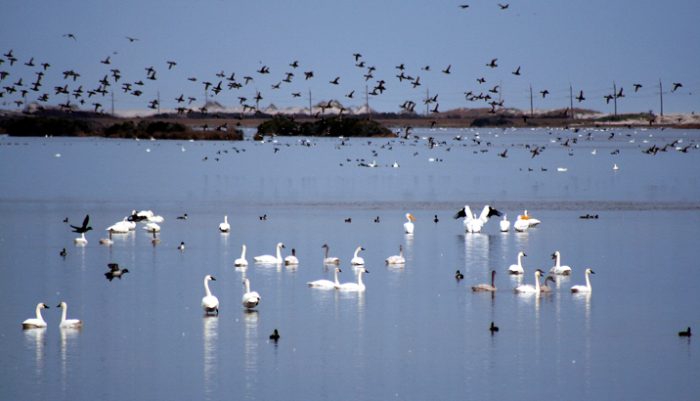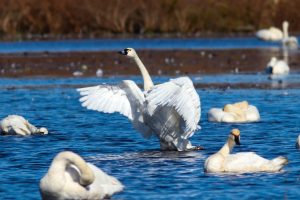
Islanders traveling along N.C. Highway 12 through Pea Island have likely noticed a lot more white – and a lot more noise – in the past few days.
This increase in activity is due to the mass return of the tundra swans, which are part-time residents of coastal North Carolina when the temperatures start to drop, and the winter season rolls around.
Tundra swans visit Eastern N.C. in droves this time of year, and Thanksgiving week is typically when the numbers are at their peak. On Pea Island, tundra swans begin to arrive in late October and stick around until the end of February or early March, and the population is at its highest in late November and early December.

The Pea Island National Wildlife Refuge has three major impoundments where the visiting birds tend to flock: the Visitors Center, the North Pond, and the South Pond, which can all be accessed via a network of walking trails.
Pea Island, as well as the greater Eastern N.C. region, is at the heart of a major migration route, (the Atlantic Flyway), which is why the area attracts so many feathered wintertime visitors. During the late fall and early winter, it is not unusual to spot hundreds if not thousands of tundra swans with one visit.
Tundra swans breed and nest on arctic tundra habitat, and are only observed in the U.S. during migration periods, and in the winter months. Eastern North Carolina provides wintering habitat for an average of 70,000 tundra swans, or roughly 65-70% of the entire eastern tundra swan population.
Alligator River National Wildlife Refuge, which is located on the Dare County mainland, is also a great place to see large groups of tundra swans and dabbling ducks like Northern pintails, green-winged teal, and gadwall.
But for Hatteras Islanders, Pea Island National Wildlife Refuge is a convenient and scenic destination to get an up-close look at these unique visitors, all winter long.
Where to See the Tundra Swans Up Close
A good starting point to see the tundra swans is the Pea Island National Wildlife Refuge Visitors Center, which connects with the North Pond Wildlife Trail, immediately behind the parking area.
Wildlife trails within the refuge are open year-round during daylight hours, and are fully disabled-accessible. Neither pets nor bicycles are allowed on walking trails, and more information can be found at https://www.fws.gov/refuge/pea_island/visit/visitor_activities/wildlife_trails.html.
Visitors can also observe tundra swans at multiple national wildlife refuges (NWR) in eastern North Carolina, including Alligator River, Pocosin Lakes, and Lake Mattamuskeet.



